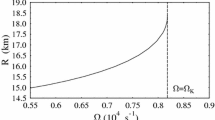Abstract
In an investigation of the evolution of homogeneous, isentropic, stars through stages of diminishing entropy, Rakavy and Shaviv (1968) have recently found that stars of mass less thanM c (Chandrasekhar's limiting mass for white dwarfs) evolve into white dwarfs, while stars of mass greater thanM c approach a (singular) state of minimum entropy. An elementary explanation of these results is given and qualitative effects of general relativity are discussed. It is found that stars which are lighter than the Oppenheimer and Volkoff (1939) limit become white dwarfs, while heavier stars must become dynamically unstable at a finite stage in their evolution.
Similar content being viewed by others
References
Chandrasekhar, S.: 1939,An Introduction to the Study of Stellar Structure, University of Chicago Press, Chicago.
Chandrasekhar, S.: 1964,Astrophys. J. 140, 417.
Kovetz, A.: 1968,Astrophys. J. 154, 241.
Kovetz, A.: 1969,Monthly Notices Roy. Astron. Soc. (in press)
Landau, L. D. and Lifshitz, E. M.: 1958,Statistical Physics, Addison-Wesley, Reading, Mass.
Oppenheimer, J. R. and Volkoff, G. M.: 1939,Phys. Rev. 55, 375.
Rakavy, G. and Shaviv, G.: 1968,Astrophys. Space. Sci. 1, 429.
Tooper, R. T.: 1964,Astrophys. J. 140, 434.
Author information
Authors and Affiliations
Rights and permissions
About this article
Cite this article
Kovetz, A. Isentropic stars in general relativity. Astrophys Space Sci 4, 365–369 (1969). https://doi.org/10.1007/BF00661825
Received:
Issue Date:
DOI: https://doi.org/10.1007/BF00661825




